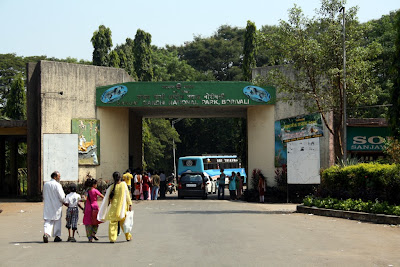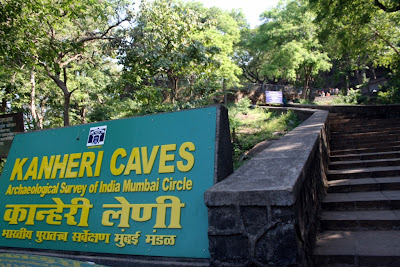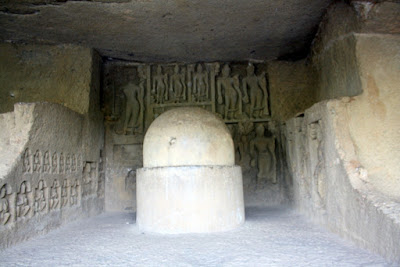The’ Lugsum Samdupling’ settlement has grown to a veritable township with monasteries, nunneries and cafes and stalls that showcase the Tibetan way of life. Bylakuppe is the largest Tibetan community in exile with about 40,000 people in five settlements containing monasteries, kindergarten to higher level secondary schools, health care clinics, a hospital and a traditional Tibetan medical facility.
As you near the settlement you will find monks in robes zipping past on two wheelers. Makes one wonder – what’s the hurry for the monks?
Ah well, the monks here are well rooted in tradition and well connected with all modern technology too.
You will see monks chatting away on a mobile phone in one hand and rolling beads on his rosary in another!
All the monks exude a friendliness and warmth towards all visitors and are ready to answer any question that is put to them.
The most visited temple here is Namdroling (The Golden Temple) and the signage is loud and clear. And of course you can spot it from afar.
The monastery attached to this temple is considered to be one of the best places for higher learning. This monastery dedicated to the teachings of Palyul Lineage of the Nyingma School of Tibetan Buddhism was established by His Holiness Pema Norbu Rinpoche shortly after he came to India from Tibet.
Three beautiful larger than life gold plated statues look down at visitors above the altar.
Buddha around 60 feet tall holds prominent place, flanked by
Guru Padmasambhava and
Amitayush (each around 58 feet tall).
The walls are adorned with colourful paintings depicting gods and demons from Tibetan Buddhist mythology.
The altar is decorated with flowers, candles and incense.
Dragons twirl up pillars on two sides of the platform.
The entrance has a curtain of beads which is the favourite of kids who love going in and out.
We stepped out and were generally looking around when we saw monks streaming into another temple nearby. We followed and were rewarded by a pleasing rendition of chants as they sat down,
opened the books on the bench in front of them and started praying.
Three of them sat at a bench where there were these long wind instruments which were blown at strategic intervals.
A senior (I think) monk played the cymbals while another
beat the drum rhythmically
After about five minutes of chanting, a couple of monks walked in with a kettle of water and offered it to a few of the monks who were chanting.
Outside on the lawns there was a group of monks relaxing from whatever they were doing and readily agreed to be photographed.
The exterior of the new Zangdokpalri temple looks majestic with a majestic rainbow arch.
We are so used to being told not to photograph the idols in temples, that the ready willingness of the monks to let the idols in their temples being photographed is such a pleasant and welcome surprise.
The nearest town for Bylakuppe is Kushal Nagar. Auto-rickshaw is the best mode for a trip to the Golden Temple from Kushalnagar town. There are frequent buses shuttling between Mysore and Madikeri. Get down at Kushalnagar.
If you are driving from Mysore towards Madikeri by SH 88, Bylakuppe appears a few kilometres ahead of Kushalnagar town. A sign board gives indication towards the left on the road to Madikeri. Kushalnagar is about 30 km (18 miles) from Madikeri town.
There's a large parking area near the Golden Temple. A shopping arcade next to it houses many curios shops and restaurants. There are not many hotels in Bylakuppe, though there is some guesthouse accommodation as part of the Monastery. Better options for stay are available at Kushalnagar and Madikeri, in that order.

 Nestled in the green environs are the glorious Kanheri caves. These caves date back to 11th century AD and beyond. As per the records work on these caves began in 1st century BC and carried on right through 11th century AD. It is 6 km from the National Park Main Gate. Kanheri comes from the Sanskrit word Krishnagiri generally meaning black in colour. They were chiseled out of a massive basaltic rock outcropping.There are 109 rock-cut cells, carved into the side of a hill. Each cave has a stone plinth for a bed. A congregation hall with huge stone pillars contains the stupa, a Buddhist shrine.
Nestled in the green environs are the glorious Kanheri caves. These caves date back to 11th century AD and beyond. As per the records work on these caves began in 1st century BC and carried on right through 11th century AD. It is 6 km from the National Park Main Gate. Kanheri comes from the Sanskrit word Krishnagiri generally meaning black in colour. They were chiseled out of a massive basaltic rock outcropping.There are 109 rock-cut cells, carved into the side of a hill. Each cave has a stone plinth for a bed. A congregation hall with huge stone pillars contains the stupa, a Buddhist shrine. Farther up the hill are the remains of an ancient water system, canals and cisterns that collected
Farther up the hill are the remains of an ancient water system, canals and cisterns that collected  and channeled the rainwater into huge tanks. Most of the caves are the Buddhist viharas meant for living, study, and meditation. The larger caves were chaityas, or halls for congregational worship, are lined with intricately carved Buddhist sculptures, reliefs and pillars, and contain rock-cut stupas for congregational worship.
and channeled the rainwater into huge tanks. Most of the caves are the Buddhist viharas meant for living, study, and meditation. The larger caves were chaityas, or halls for congregational worship, are lined with intricately carved Buddhist sculptures, reliefs and pillars, and contain rock-cut stupas for congregational worship. 



 The façade of the hall is pierced by three doors with two groups of two couples, each group
The façade of the hall is pierced by three doors with two groups of two couples, each group 

 mudra and other Bodhisattva images. These sculptures are of later additions and are datable to around 5th – 6th centuries A.D.
mudra and other Bodhisattva images. These sculptures are of later additions and are datable to around 5th – 6th centuries A.D. Cave 11 which is also known as ‘Darbar Hall’ consists of a huge hall with a front verandah.
Cave 11 which is also known as ‘Darbar Hall’ consists of a huge hall with a front verandah.








